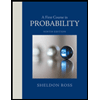The following table gives the joint probability distribution of the speed of a car (C) and the incidence of an accident (A), where A=0 when no accidents have occurred and A=1 when an accident has occurred: Use the law of iterated expectations to calculate E(C)
The following table gives the joint probability distribution of the speed of a car (C) and the incidence of an accident (A), where A=0 when no accidents have occurred and A=1 when an accident has occurred: Use the law of iterated expectations to calculate E(C)
A First Course in Probability (10th Edition)
10th Edition
ISBN:9780134753119
Author:Sheldon Ross
Publisher:Sheldon Ross
Chapter1: Combinatorial Analysis
Section: Chapter Questions
Problem 1.1P: a. How many different 7-place license plates are possible if the first 2 places are for letters and...
Related questions
Question
Ma3.
The following table gives the joint
Use the law of iterated expectations to calculate E(C)

Transcribed Image Text:A=0
A = 1
C= 30 kmph C= 55 kmph
0.30
0.07
0.05
0.13
C=85 kmph
0.10
0.35
Expert Solution
This question has been solved!
Explore an expertly crafted, step-by-step solution for a thorough understanding of key concepts.
Step by step
Solved in 5 steps

Recommended textbooks for you

A First Course in Probability (10th Edition)
Probability
ISBN:
9780134753119
Author:
Sheldon Ross
Publisher:
PEARSON


A First Course in Probability (10th Edition)
Probability
ISBN:
9780134753119
Author:
Sheldon Ross
Publisher:
PEARSON
